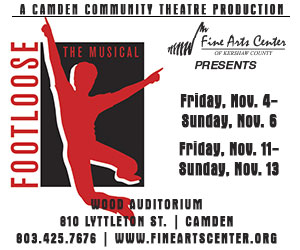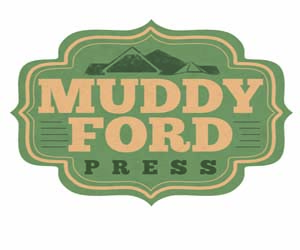Eavesdropping – Writers Jamie Ridenhour and Amy Reeves Converse about Writing
Imagine Downton Abbey. With werewolves.
And imagine Jack the Ripper as an after-school special. (Remember those?) And the main character, Abbie, is kinda like one of Patricia Arquette’s freaky psychic daughters from Medium—she has visions—but smarter and spunkier, played maybe by a slightly older Ariel Winter from Modern Family (the smart middle kid, Alex). There’s a love triangle, too, but Abbie is still more Hermione from Harry Potter than that twit Bella from Twilight. And then there’s that secret brotherhood….
Two graduates from the University of South Carolina have recently published novels that blend and bend the conventions of genre fiction—whodunits, young adult lit, fantasy fiction. Jamie Ridenhour’s Barking Mad (Typecast, 2011) is a werewolf murder mystery set in 1930s England, narrated by Reggie Spiffington, a clueless idler with a voice straight out of Jeeves and Wooster. Amy Reeves has just published Ripper (Flux/Llewellyn 2012), historical fiction with a paranormal twist for young adult readers.
Both graduated from USC with Ph.D. degrees in nineteenth-century British literature— Amy researching Romantic era children’s literature, Jamie focusing on Victorian and gothic fiction (he recently edited the Valancourt scholarly edition of the Victorian vampire novel Carmilla, a precursor to Dracula). Amy has published articles on children’s literature and Wuthering Heights, and Jamie on vampire fiction, Charles Dickens, and steam punk rapper Professor Elemental. Jamie has also written a couple of award-winning fairytale horror films: Cornerboys and The House of the Yaga. And both teach college English, Jamie for the past few years at University of Mary in North Dakota, Amy at Columbia College and now at USC in Columbia.
Jasper asked them to get together (in cyberspace) and talk about their work as novelists, and they agreed—talking about historical research, the demands of genre, dead bodies, self-publishing, and the need for jogging, jazz, and coffee.
AMY: In Barking Mad, Reggie has a very distinct voice—he is just such a solidly insouciant rogue throughout. His cavalier attitude continues even during the werewolf transformations. Not an easy thing to do, so how did you do it?
JAMIE: The true answer is that I spent twenty-some-odd years reading murder-mysteries, P.G. Wodehouse, and Charles Dickens. The “type,” the rich clueless idler, is a staple of those fictions, particularly Wodehouse. But after that initial inspiration (or theft—tomato/to-mah-to), Reggie’s voice just sort of developed on its own. As I got to know him better, it became clearer what he would say in a particular situation, how we would react. His voice was the most important factor in the book, shaping character, narrative, everything.
AMY: Reggie’s primary interests are women, fashion, and food. In future Reggie books is he going to remain the same, or branch out into other interests like say social justice?
JAMIE: There are two further stories mapped out, a novel and a short story. Reggie’s got potential to go deeper, but he has an overwhelming sense of inertia that’s hard to overcome. When he does move towards real thought, it’s because those around him push him there. Pelham or Mimsy have these ideas; they’d never occur to Reggie on his own.
AMY: How did you come up with the idea for your next project, a young adult novel, Charley Cross and the London Dead? What inspired you?
JAMIE: Charley Cross was inspired by a brief section, a couple of pages really, of Arthur Machen’s 1895 novel The Three Impostors. In that book, a woman tells about seeing her brother being taken through the streets of London by a dead man—rotting flesh, empty eyes, etc.—and when she gives chase she loses them in the crowd. It’s a creepy little vignette, but it’s never followed up on because she’s lying; it didn’t happen. I was quite disappointed. So that’s how Charley Cross started, with me trying to tell the end of that story. It’s gotten a lot bigger than that, of course. And it incorporates elements of an earlier novel I had been stalled on for years. Talk to me about Victorian London. Clearly we’re both enamored by it—what makes it a setting you want to work with?
AMY: I think the fascinating aspect of Victorian London is the mask of prudery that the culture wore—the sexual repression, rigid class etiquette—and yet prostitution was rampant, there was great interest in spiritualism and the occult, and also there was such a rich, bohemian artistic life that flourished in the Pre-Raphaelite movement. I was drawn to the period because it was such a rich and textured background to work with for my novel. What draws you to the Victorian period? Why did you decide to use it as the setting for your YA book?
JAMIE: Mainly it’s training. Victorian London is the setting for many of the stories that were formative for me: Dracula, Jekyll and Hyde, Holmes, Charles Dickens. And like you say, there’s infinite possibility for stories there, which is why it’s traditionally been such a deep well for storytellers. But Ripper is grounded in real historical events—the Whitechapel murders of 1888. How much research do you do? Do you do all your research ahead of time, assembling facts before you begin writing, or does the research grow out of the story as you compose?
AMY: Researching the actual Ripper murders and aspects of the period was time-consuming but not very difficult. Because of my dissertation, I already knew what sources to go through to find specific information on nineteenth-century culture. Finding information on hospitals, on what physicians knew at the time, what a birth would have been like was much more difficult for me. This took a lot more digging. One very helpful book that I found was Harold Speert’s book Obstetrics and Gynecology; the book had pictures of medical instruments from ancient times onward.
JAMIE: A lot of the frisson, for me, of writing historical fiction, is the tension between the historical moment and our own twenty-first-century sensibilities. For instance, your Abbie Sharp is a lot more independent and willing to push boundaries than a sixteen-year-old in 1888 would have been. Are you conscious of that tension while you’re writing? Is it restricting at all?
AMY: True, Abbie Sharp is more independent and career-focused than the typical Victorian girl would be. But the fact remains that there were individual women in the Victorian era who lived more independently, who forged lives and careers on their own. One of my all-time favorite women of the period, Elizabeth Garrett Anderson, fought her way through the patriarchal system to become one of the first female physicians and to start the first medical school for women in London. This was also the beginning of the suffragist movement and, of course, we cannot forget the feminists Amelia Bloomer and Dr. Anderson’s sister Millicent Fawcett. Abbie Sharp, in my mind, is among these types, willing to push against the limits and boundaries set upon her. Furthermore, I used her unconventional Dublin life, the influence of her educated mother, to make her independence more believable. Do any historical periods other than the Victorian or Wodehouse eras tempt you as a setting?
JAMIE: My grandfather was a waist-gunner on a B-17, stationed in England during WWII, and I’ve played around with the idea of building something from that. I have a fictional 70s-era rock band that will eventually feature in a ghost novel, though right now they just exist as a long entry in a fictional Encyclopedia of Rock. I’ve written short fiction set in the 1930s Deep South, and in SC in the 1980s. I’ll go anywhere. So, we’re both working in fairly well-established genres in our novels. How much do you worry about generic conventions? Readers expect certain elements and narrative moves—does that inform your writing on a practical level? Did you feel pressure, for instance, to have a love triangle?
AMY: I keep the market in mind when I am initially thinking of a story. For instance, when I began thinking about writing Ripper, I thought the subject would have a mass appeal. Jack the Ripper is an intriguing subject to almost anyone. That said, I knew the Pre-Raphaelite sub-plot would be harder to sell to teen readers, but I knew from the start that it had to be part of my Ripper story, which I wanted to go beyond a typical whodunit. My burden was to present it in a way that would be intriguing to young readers who weren’t familiar with the lesser-known story. As to the love triangle, for me, it has its roots in Jane Eyre rather than an attempt to meet the expectations of readers.
JAMIE: On a similar note, what do you think about the proliferation of self-publishing? Barring vanity presses and the glut of bad writing, is self-publishing a valid avenue for talented and motivated writers?
AMY: I think that self-publishing is usually a bad idea. First, it is expensive. Furthermore, since getting Ripper published, I have realized all the teamwork involved in putting out a book. My editor gave me wonderful feedback and offered his views and perspectives on aspects of the book that I never would have considered. My copy editor also had a very sharp eye for minor grammatical errors and inconsistencies in the storyline. In spite of the hundreds of times I read the book myself, I really needed their input. Even the best of writers needs a professionally-trained editorial team, and this is not often possible with self-published works.
Barking Mad came out with the independent press, Typecast. Do you recommend that unpublished writers pursue independent publishers?
JAMIE: I think it depends on what you want. Small presses don’t have the promotional budget of HarperCollins or Random House, but they also won’t drop you after six months if you haven’t sold a quota. The best thing about working with Typecast is that they treat me like an important part of the organization. I can pick up the phone and call my editor any time and she’ll answer. Barking Mad has been out for nine months, and Jen is still calling me with brainstorms for promotion, etc. They make beautiful books, and I’m on a roster with some pretty impressive writers, Matt Hart and Matthew Lippman among them. I’ll be shopping Charley Cross to agents and bigger houses, largely because of its genre, but I’m very happy to be with Typecast.
AMY: What is your writing routine? Do you tend to be more productive in the mornings or at night? Do you have any drinks, snacks, or props that you must have at your writing desk?
JAMIE: I get up at 5 each morning and write for an hour or two, depending on when my son has to be at band. If I’m lucky I can work in time in the evening as well. Coffee is pretty crucial, as is music. Early morning sessions usually mean cool jazz—Dexter Gordon or Sonny Stitt. I have a cozy little office, with some tchochkes to keep me company. A nineteenth-century phrenology head watches most of what I do. What about you?
AMY: Typically, I like to go on a jog first thing in the morning with my dog Annie while listening to my iPod. I work out a lot of plot problems or get ideas while jogging. Then I go home and with the dogs at my feet and a large mug of coffee, I write. I tend to be very solitary in my writing, only giving initial drafts to one or two very good close writer friends and my agent. I do enjoy interacting with other authors and readers through Goodreads, SCBWI, blogging, and social media in an attempt to keep up to date on what is happening in the literary and publishing world. How important is blogging to your social media? Do you think a debut writer should blog or does it become a distraction?
JAMIE: Done right it can be a very effective tool. I have a blog—it’s the “News” section of jamiesonridenhour.com—but I don’t think I’m using it to its full potential. My wife, who is an educational reform advocate, is a great role model—her blog gets followed and retweeted all over the world. Mine just sort of sits there. I use Twitter (@jmridenhour) and Facebook quite a bit, and recently added a Twitter account for Reginald Spiffington (@rspiffington), which is a lot of fun. I like connecting with readers and other writers in a real conversation.
For more about Jamie Ridenhour (and to watch his remarkable little films), he is online at: www.jamiesonridenhour.com. You can order Barking Mad at Typecast Publishing (http://www.typecastpublishing.com/barkingmad/). You can find out more about Amy Reeves and her books at her website: amycarolreeves.com.






.jpg)
